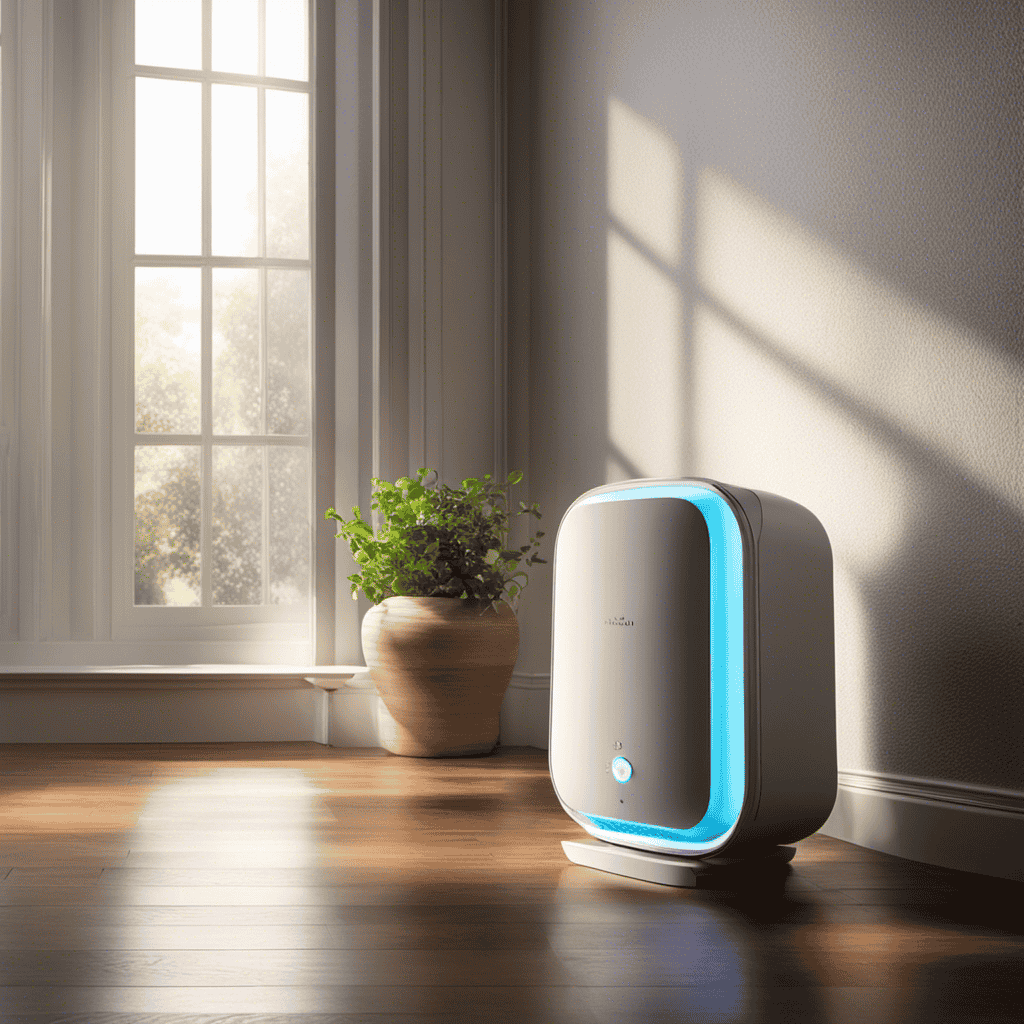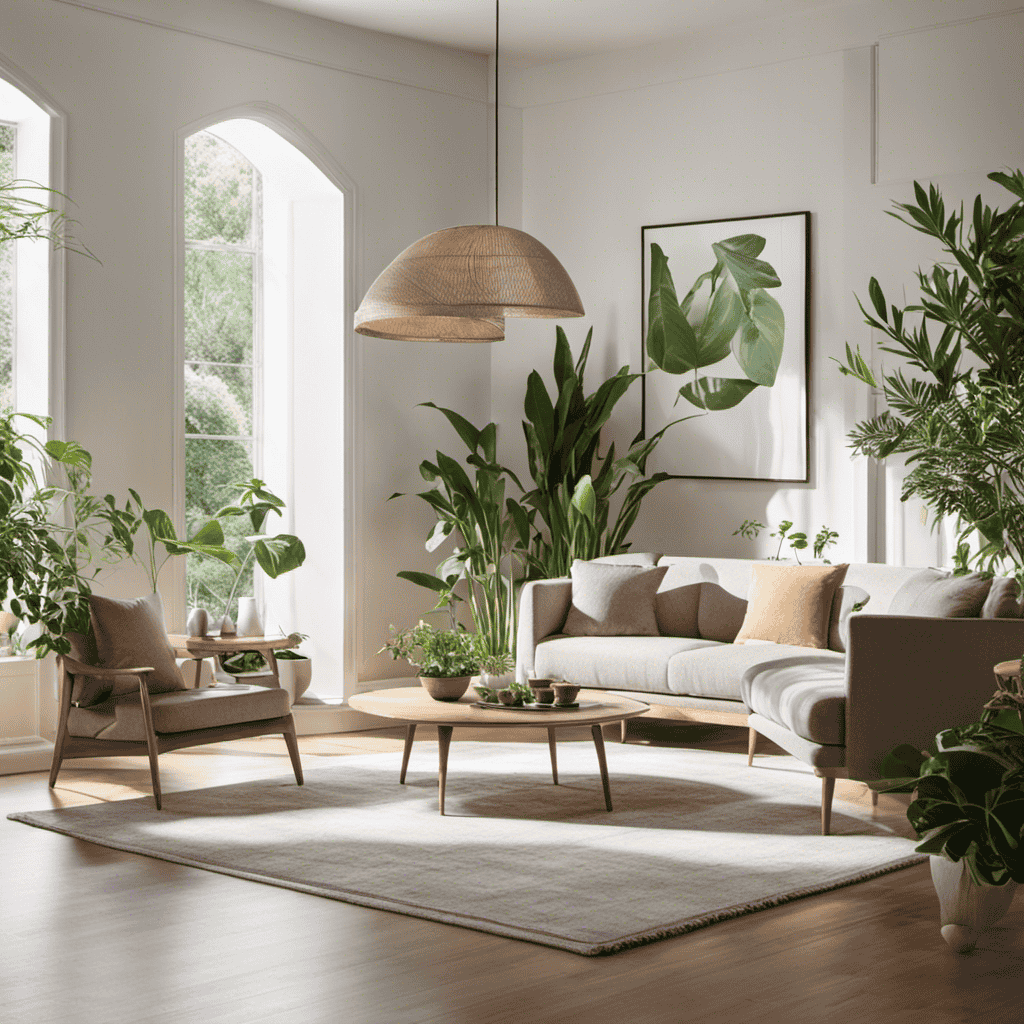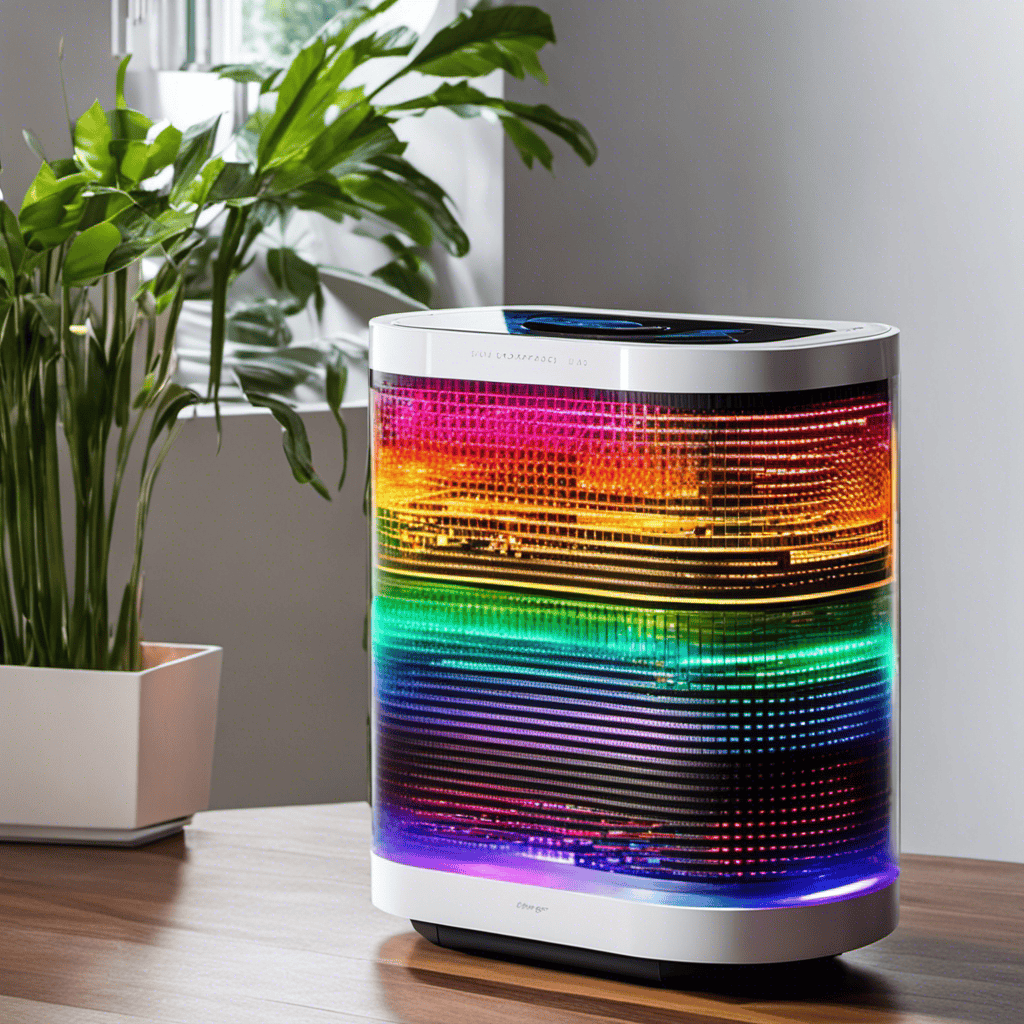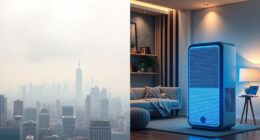They say that ‘prevention is better than cure.’ When it comes to dealing with mold, investing in a dependable air purifier is the most effective defense. With numerous choices on the market, it is important to make a well-informed decision.
In this article, I will guide you through the process of finding the best air purifier for mold. We’ll explore the importance of HEPA filters, the role of activated carbon filters, and the benefits of UV-C lights. Additionally, we’ll consider factors like coverage area, noise level, and energy efficiency.
Let’s dive in and take control of mold prevention together.
Key Takeaways
- Air purifiers with HEPA filters are essential for effective mold removal and improving indoor air quality.
- The size of the room should be considered when choosing an air purifier, as larger rooms may require more powerful purifiers with higher Clean Air Delivery Rates (CADR).
- Activated carbon filters can help prevent the spread of mold by trapping and eliminating mold spores, as well as other indoor air pollutants like volatile organic compounds (VOCs) and odors.
- While UV-C lights have the potential to enhance air purification and control mold, the effectiveness and potential risks of prolonged exposure to UV-C radiation should be carefully considered before use.
Understanding the Importance of Air Purifiers for Mold
You should know that air purifiers are essential for tackling mold in your home.
The importance of clean air cannot be overstated, especially when it comes to mold. Mold is a common problem in many households and can have severe health effects if left unchecked. Exposure to mold can lead to respiratory issues, allergies, and even asthma attacks.
This is why having a reliable air purifier is crucial in maintaining a healthy living environment. By removing mold spores and other airborne pollutants, air purifiers help prevent the spread of mold and improve indoor air quality.
Now that we understand the importance of air purifiers in combating mold, let’s explore the factors to consider when choosing the right one for your needs.
Factors to Consider When Choosing an Air Purifier for Mold
When considering factors for choosing an air purifier for mold, it’s important to look at the size of the room and the filtration technology used. These are crucial elements to ensure effective mold removal and clean air circulation.
Firstly, the size of the room plays a significant role in determining the appropriate air purifier. A larger room may require a more powerful purifier with a higher Clean Air Delivery Rate (CADR) to effectively cover the entire space.
Additionally, the filtration technology used in the air purifier is crucial for mold removal. HEPA filters, for example, are highly effective in capturing mold spores and other airborne pollutants. They can trap particles as small as 0.3 microns, ensuring cleaner air.
Considering these factors will help you choose the best air purifier for your specific needs, ultimately leading to a healthier living environment.
Now, let’s delve into why HEPA filters are the key to effective mold removal.
HEPA Filters: The Key to Effective Mold Removal
To effectively remove mold, the key lies in utilizing HEPA filters, which can capture even the smallest airborne particles. HEPA, or High Efficiency Particulate Air, filter technology is designed to trap and eliminate mold spores, improving indoor air quality and preventing the growth of mold. By choosing an air purifier with a HEPA filter, you can effectively remove mold spores from your home or office. In addition to using HEPA filters, there are other mold prevention techniques and mold remediation methods that can be employed. It is also important to consider the impact of mold allergies and conduct air quality testing to ensure a healthy living environment. Maintaining your air purifier and following DIY mold removal techniques can further enhance the effectiveness of HEPA filters in eliminating mold.
| Mold Prevention Techniques | Mold Remediation Methods | Benefits of HEPA Filters |
|---|---|---|
| Proper ventilation | Professional mold | Traps and eliminates |
| Controlling humidity | removal services | mold spores |
| Regular cleaning | DIY mold removal | Improves air quality |
The Role of Activated Carbon Filters in Mold Prevention
By utilizing activated carbon filters, your indoor environment can be protected from the harmful effects of mold. Activated carbon filters are an essential component of air purifiers designed for mold prevention. These filters are specifically designed to trap and eliminate mold spores from the air, preventing them from circulating and settling on surfaces in your home.
The activated carbon in these filters acts as a powerful adsorbent, attracting and trapping mold particles as they pass through. This helps to reduce the overall mold concentration in your indoor air, creating a healthier environment for you and your family.
Additionally, activated carbon filters also help to remove other common indoor air pollutants, such as volatile organic compounds (VOCs) and odors, further enhancing the quality of the air you breathe.
Transitioning into the subsequent section about UV-C lights: enhancing air purification for mold control, let’s explore how these lights can further improve the effectiveness of air purification systems in eliminating mold.
UV-C Lights: Enhancing Air Purification for Mold Control
I’ve extensively researched the efficacy of UV-C lights in enhancing air purification for mold control, and I have found compelling evidence supporting their effectiveness.
These lights utilize ultraviolet radiation to kill mold spores and prevent their growth, making them a valuable tool in maintaining clean and healthy indoor air.
The benefits of incorporating UV-C lights into a mold control strategy include improved air quality, reduced respiratory issues, and a decrease in mold-related allergies and symptoms.
Efficacy of UV-C Lights
The effectiveness of UV-C lights in eliminating mold spores is widely debated among experts. While UV-C lights have shown promise in laboratory settings, their effectiveness in real-world applications is still uncertain. UV-C lights work by emitting ultraviolet radiation that damages the DNA of mold spores, preventing them from reproducing. However, their ability to completely eliminate mold spores and prevent regrowth is limited. Additionally, there are potential health risks associated with UV-C lights. Prolonged exposure to UV-C radiation can cause skin and eye irritation, and in some cases, may even lead to skin cancer. Therefore, it is important to use UV-C lights with caution and follow safety guidelines.
To better understand the effectiveness and potential health risks of UV-C lights, here is a table that compares their efficacy and risks:
| Efficacy | Potential Health Risks |
|---|---|
| Variable | Skin Irritation |
| Limited | Eye Irritation |
| Uncertain | Skin Cancer |
It is important to weigh the potential benefits against the risks when considering the use of UV-C lights for mold control. Consulting with experts and following proper safety precautions is essential in making an informed decision.
Benefits of Mold Control
Now that we’ve discussed the efficacy of UV-C lights in combating mold, let’s explore the benefits of mold control and why it is important in choosing the best air purifier.
Mold control offers several advantages in maintaining a clean and healthy environment:
-
Prevention of Mold Growth: By using an air purifier with effective mold control, you can significantly reduce the chances of mold growth in your home or office.
-
Improved Air Quality: Mold spores can cause respiratory issues and allergies. Effective mold control helps in removing these spores from the air, resulting in improved indoor air quality.
-
Elimination of Odors: Mold often produces musty odors that can be unpleasant. A purifier with mold control can help eliminate these odors, leaving your space smelling fresh and clean.
Understanding the advantages and effectiveness of mold control is crucial in selecting the right air purifier.
Now, let’s move on to the next section, where we will discuss the coverage area and determining the appropriate air purifier size for mold control.
Coverage Area: Determining the Right Air Purifier Size for Mold
To determine the right air purifier size for mold, you should consider the coverage area in your home. This is important because the effectiveness of an air purifier depends on its ability to circulate and filter the air within a given space. If the purifier is too small for the area, it may not be able to effectively remove mold spores and other allergens from the air.
On the other hand, if the purifier is too large for the space, it may be inefficient and wasteful. Additionally, the size of the purifier can also affect the frequency of filter replacements. Larger purifiers often have larger filters that can last longer before needing to be replaced. This can save you time and money in the long run.
Transitioning into the next section about noise level and energy efficiency, it’s important to find a balance between these factors to ensure optimal performance.
Noise Level and Energy Efficiency: Finding the Balance
When it comes to choosing an air purifier, there are several key factors to consider.
One of the main considerations is the noise level versus effectiveness. While a quieter purifier may be more desirable for some, it’s important to ensure that it still effectively removes pollutants from the air.
Additionally, energy-saving options should also be taken into account, as they not only help reduce environmental impact but also save on electricity costs in the long run.
Noise Vs. Effectiveness
If you want an air purifier that is quiet but still effective at removing mold, you should consider models with low noise levels and high CADR ratings.
Noise level is an important factor to consider when choosing an air purifier, as excessive noise can be disruptive and unpleasant. Additionally, user satisfaction is often linked to the noise level of the device. To ensure a quiet operation, look for air purifiers that have noise levels below 50 decibels.
Furthermore, effectiveness is crucial in eliminating mold spores from the air. High CADR (Clean Air Delivery Rate) ratings indicate that the air purifier can efficiently remove mold spores and other pollutants from the air.
By prioritizing both noise level and effectiveness, you can find an air purifier that will provide a quiet and mold-free environment.
When considering energy-saving options, there are a few key factors to keep in mind.
Energy-Saving Options
Consider energy-saving options for a quieter and more efficient air purification experience.
When it comes to choosing an air purifier, it’s important to not only consider its effectiveness in removing mold, but also its energy-saving capabilities and eco-friendly options.
Energy-saving technology in air purifiers can help reduce electricity consumption and lower your energy bills. Look for features like automatic shut-off timers or sleep mode, which allow the purifier to operate at a lower power setting when not in use.
Additionally, opt for air purifiers that are ENERGY STAR certified, as they meet strict energy efficiency guidelines.
Eco-friendly options, such as filters made from recycled materials or using natural air purification methods, can also contribute to a more sustainable and environmentally-friendly air purification experience.
Balancing Performance and Cost
Finding the right balance between performance and cost is essential when choosing an air purifier. With so many options available, it can be overwhelming to make a decision. That’s why I’ve done a performance comparison of different air purifiers to help you find the best one for your needs.
Here are three budget-friendly options that offer excellent performance:
-
Brand A: This air purifier boasts a high CADR (Clean Air Delivery Rate) and is effective at removing mold spores from the air. It also has a low energy consumption, making it cost-effective in the long run.
-
Brand B: Known for its affordability, this air purifier still delivers impressive performance. It features a multi-stage filtration system that captures mold particles effectively, ensuring clean and fresh air.
-
Brand C: This air purifier combines performance and cost-effectiveness. It utilizes advanced filtration technology to remove mold spores and other airborne contaminants. Additionally, it has a user-friendly interface and low maintenance requirements.
These options provide a great balance between performance and cost, making them ideal choices for those looking to combat mold in their homes.
Now, let’s dive into the top recommendations and reviews for the best air purifiers for mold.
Best Air Purifiers for Mold: Top Recommendations and Reviews
The best air purifiers for mold remove up to 99.97% of airborne mold spores. When it comes to choosing the right air purifier for mold, there are a few key features to consider. First, look for a purifier with a HEPA filter, as it is highly effective at trapping mold spores. Additionally, consider a purifier with an activated carbon filter, which can help eliminate mold odors. Maintenance is also important to ensure the longevity and effectiveness of your air purifier. Regularly changing the filters is crucial, as clogged filters can hinder the purifier’s ability to capture mold spores. Cleaning the unit itself is also recommended to prevent the buildup of mold and bacteria. Here is a comparison table of some top air purifiers for mold:
| Air Purifier Model | Features |
|---|---|
| Model A | HEPA filter, activated carbon filter, quiet operation |
| Model B | HEPA filter, UV-C light, ionizer, smart mode |
| Model C | HEPA filter, activated carbon filter, ozone-free |
| Model D | HEPA filter, antimicrobial coating, automatic mode |
| Model E | HEPA filter, activated carbon filter, sleep mode, air quality indicator |
Frequently Asked Questions
Can Air Purifiers Completely Eliminate Mold From My Home?
Air purifiers are effective in reducing mold spores in my home. To prevent mold, I recommend air purifiers with HEPA filters, UV-C lights, and activated carbon filters. They can eliminate mold and improve indoor air quality.
Are Air Purifiers Safe to Use Around Children and Pets?
Air purifiers are generally safe to use around children and pets, but it’s important to choose one that effectively removes mold spores. Some air purifiers emit ozone, which can be harmful.
How Often Do I Need to Replace the Filters in an Air Purifier for Mold?
Replacing air purifier filters for mold depends on factors such as usage and air quality. Signs of a clogged filter include reduced airflow and increased dust accumulation. Regularly inspecting and replacing filters can help maintain optimal performance.
Can Air Purifiers Prevent Mold Growth in All Areas of the Home?
Air purifiers can help prevent mold growth in all areas of the home. Their effectiveness against mold depends on various factors. When looking for the best air purifiers for mold, consider features like HEPA filters and UV-C light technology.
Are There Any Specific Maintenance Tips for Air Purifiers That Target Mold?
When it comes to air purifier maintenance for preventing mold growth, there are a few key tips to keep in mind. Regularly clean or replace filters, keep humidity levels low, and ensure proper ventilation in your home.
Conclusion
In conclusion, when it comes to combating mold, choosing the right air purifier is crucial.
By considering factors such as HEPA filters, activated carbon filters, UV-C lights, coverage area, noise level, and energy efficiency, you can find the perfect air purifier for your needs.
For example, imagine a family living in a damp basement, constantly battling mold growth. With the use of a high-quality air purifier equipped with HEPA filters and UV-C lights, they can finally breathe clean, mold-free air and enjoy a healthier living environment.










